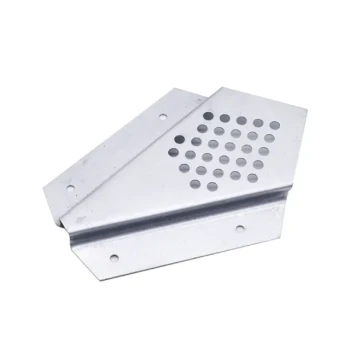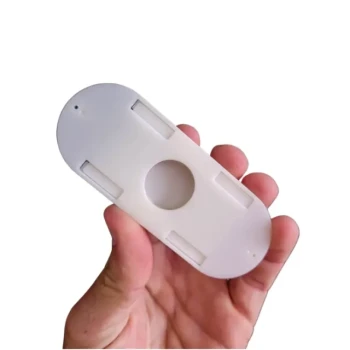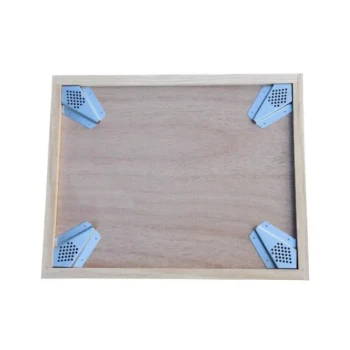The ideal height for your bee house is between 6 and 7 feet (approximately 2 meters) off the ground. Placing it at this height makes it easily accessible for the bees while keeping it safe from ground-level moisture and many common predators. This specific placement is a key part of creating a stable and protected environment for solitary bees to nest successfully.
The correct height is not just a number; it's a strategy. The ultimate goal is to shield the nesting bees from harsh weather and predators, and a height of 6-7 feet on a stable surface is the most effective way to achieve this.
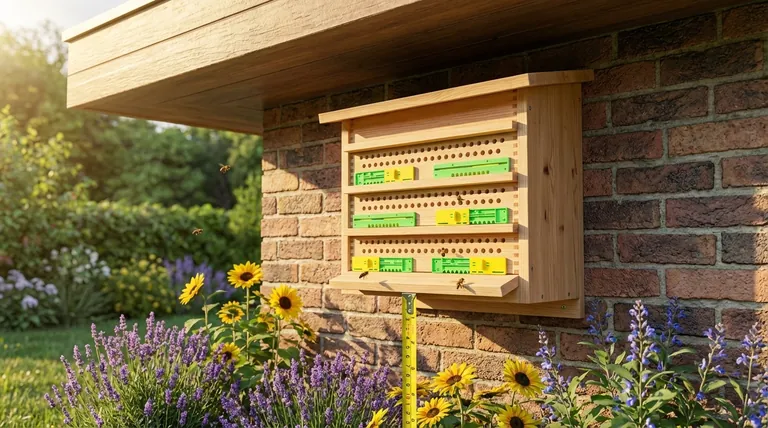
Why Placement is Critical for Bee Survival
Simply putting up a bee house is not enough to attract and sustain a healthy population of solitary bees like mason or leafcutter bees. The location you choose directly impacts their ability to survive and reproduce.
Achieving the Optimal Height
The 6 to 7-foot range is considered the sweet spot. It's high enough to avoid splash-back from rain hitting the ground and to deter predators like skunks or mice. At the same time, it remains at or near human eye level, allowing you to easily observe bee activity and perform yearly maintenance without needing a ladder.
The Importance of Shelter from Weather
Solitary bee cocoons are vulnerable to mold and rot caused by excessive moisture. The single most effective way to protect your bee house is to place it under an eave of a house, shed, or garage. This overhang provides critical protection from both direct rain and the intense midday sun.
If you don't have an eave, select a bee house with a significant roof overhang (at least 2-3 inches) to serve the same function.
Providing Morning Sun Exposure
Bees are cold-blooded and rely on the sun's warmth to become active. Mounting your bee house so it faces south or southeast is crucial. This orientation allows the house to capture the gentle morning sun, warming the bees and encouraging them to begin foraging for pollen and nectar earlier in the day.
Ensuring a Stable and Secure Mounting
A bee house should never swing or sway. Unlike a birdhouse, it must be mounted securely to a flat, stable surface like a wall or a sturdy fence post. Constant motion can disorient the bees, damage developing larvae, and make it difficult for them to access their nesting tunnels.
Common Pitfalls to Avoid
Many well-intentioned bee habitats fail due to simple placement mistakes. Understanding these trade-offs and pitfalls is essential for success.
Placing It Too Low
Mounting a house below 5 feet increases its vulnerability. It is more susceptible to ground moisture wicking into the nesting materials and becomes an easy target for curious pets or predators.
Placing It Too High
Going above 7-8 feet makes inspection and maintenance difficult. More importantly, it can expose the house to stronger winds and driving rain that might bypass the protection of an eave.
The "Swinging in the Breeze" Mistake
One of the most common errors is hanging a bee house from a tree branch. The constant swaying is highly detrimental to the bees and their offspring. Always fasten it securely to a non-moving surface.
Overlooking Nearby Resources
Placement isn't just about the house itself. Mason bees need a source of mud to build their nest walls, and all bees need flowers for pollen and nectar. Ensure these resources are available within a 300-foot radius of the house.
Setting Up Your Bee House for Success
Use these guidelines to choose the perfect spot based on your specific environment.
- If your primary focus is maximum bee safety and productivity: Mount it 6-7 feet high under a solid eave, ensuring it faces south or southeast to catch the morning sun.
- If you have no eaves available: Choose a bee house with a deep, protective roof and fasten it securely to a sturdy post or wall at the 6-7 foot height.
- If you want to easily observe your bees: Position the house at your eye level within the recommended height range, but place it away from high-traffic walkways to avoid disturbing their flight paths.
By providing the right height, orientation, and protection, you create a thriving habitat that supports these essential pollinators for years to come.
Summary Table:
| Key Factor | Ideal Specification | Why It Matters |
|---|---|---|
| Height | 6-7 feet (approx. 2 meters) | Protects from ground moisture and predators like skunks/mice |
| Orientation | South or Southeast facing | Captures morning sun to warm bees for early foraging |
| Mounting | Securely fixed to a wall or post (no swinging) | Prevents disorientation and damage to larvae |
| Shelter | Under an eave or with a deep roof overhang | Shields from direct rain and intense midday sun |
Ready to support your solitary bee population with the right equipment? At HONESTBEE, we supply durable, weather-resistant bee houses and beekeeping supplies designed for commercial apiaries and distributors. Our products are built to meet the exact placement guidelines for optimal bee health and productivity. Contact our wholesale experts today to discuss your needs and ensure your bee habitats are set up for long-term success.
Visual Guide
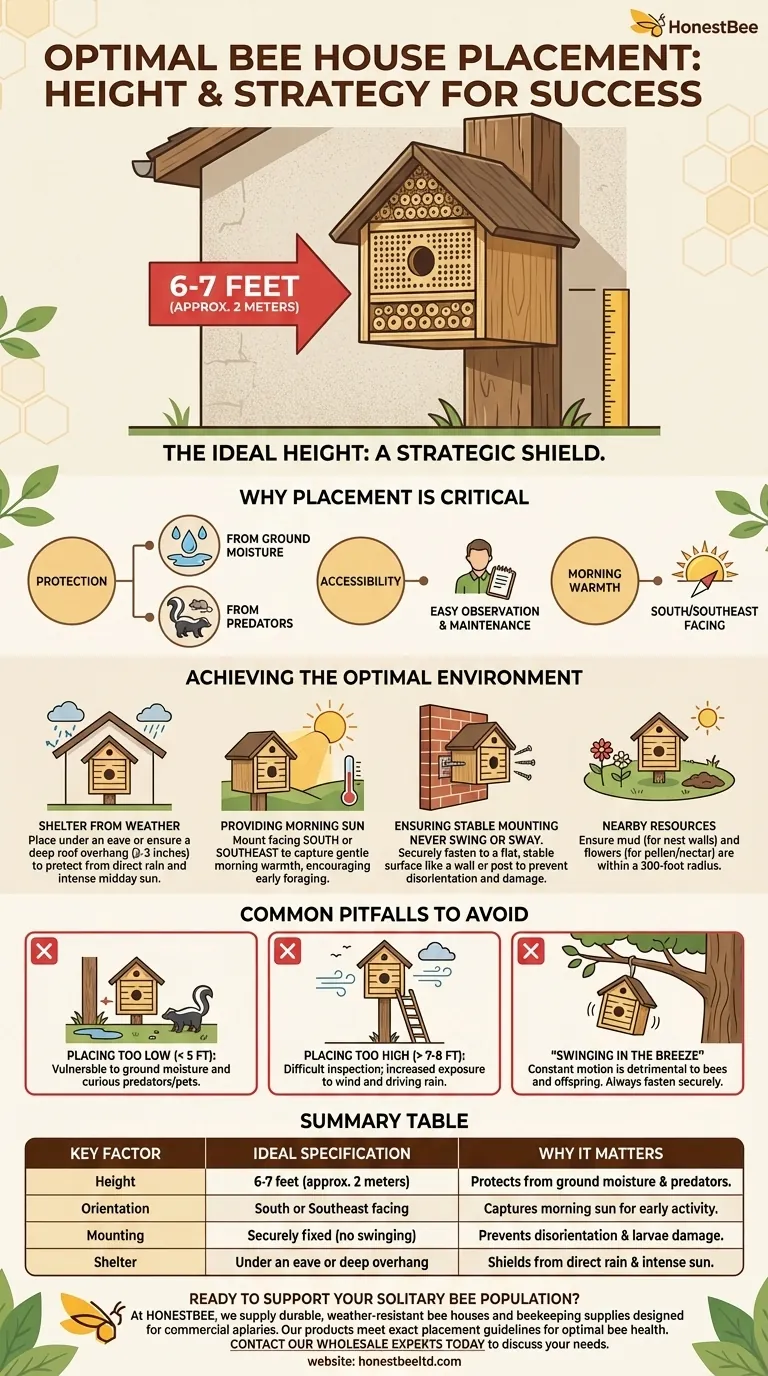
Related Products
- Multi-Functional Sliding Hive Entrance for Beekeeping
- Brown Nicot Queen Cell Cups for Breeding Queen Bees Beekeeping
- Heavy Duty Metal Corner Bee Escape for Reliable Hive Clearing
- Professional Galvanized Hive Strap with Secure Locking Buckle for Beekeeping
- Professional Durable Two-Piece Plastic Bee Escape
People Also Ask
- How does the sliding design of the entrance reducer benefit beekeepers? Achieve Ultimate Hive Control
- What additional functions do hive entrances serve? A Key to Colony Health, Security, and Productivity
- What are the different entrance sizes for an 8 or 10-frame Langstroth hive? A Guide to Seasonal Management
- How does entrance configuration vary seasonally for beekeepers? A Guide to Year-Round Hive Health
- How can a Langstroth hive entrance be adjusted? Mimic Natural Bee Preferences for a Healthier Hive


